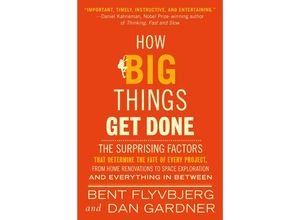“Why do big projects go wrong so often and are there any lessons you can use when renovating
your kitchen? Bent Flyvbjerg is the ‘megaproject’ expert and Dan Gardner brings the
storytelling skills to How Big Things Get Done with examples ranging from a Jimi Hendrix
studio to the Sydney Opera House.”— Financial Times “Entertaining . . . There are lessons
here for managers of all stripes.”— The Economist A BEST BOOK OF THE YEAR: Economist
Financial Times CEO Magazine Morningstar Finalist for the Porchlight Business Book Award
the Financial Times and Schroders Business Book of the Year Award and the Inc. Non-Obvious
Book Award Nothing is more inspiring than a big vision that becomes a triumphant new
reality. Think of how the Empire State Building went from a sketch to the jewel of New York’s
skyline in twenty-one months or how Apple’s iPod went from a project with a single employee to
a product launch in eleven months. These are wonderful stories. But most of the time big
visions turn into nightmares. Remember Boston’s “Big Dig”? Almost every sizeable city in the
world has such a fiasco in its backyard. In fact no less than 92% of megaprojects come in over
budget or over schedule or both. The cost of California’s high-speed rail project soared from
$33 billion to $100 billon—and won’t even go where promised. More modest endeavors whether
launching a small business organizing a conference or just finishing a work project on time
also commonly stall out. But why do some projects fail? Understanding what distinguishes the
triumphs from the failures has been the life’s work of Oxford professor Bent Flyvbjerg dubbed
“the world’s leading megaproject expert.” In How Big Things Get Done he identifies the errors
in judgment and decision-making that lead projects both big and small to fail and the
research-based principles that will make you succeed with yours. For example: • Understand
your odds. If you don’t know them you won’t win. • Plan slow act fast. Getting to the action
quick feels right. But it’s wrong. • Think right to left . Start with your goal then
identify the steps to get there. • Find your Lego. Big is best built from small. • Be a team
maker. You won’t succeed without an “us.” • Master the unknown unknowns. Most think they can’t
so they fail. Flyvbjerg shows how you can. • Know that your biggest risk is you. Full of
vivid examples ranging from the building of the Sydney Opera House to the making of Pixar
blockbusters to a home renovation in Brooklyn gone awry How Big Things Get Done reveals how
to get any ambitious project done—on time and on budget.

